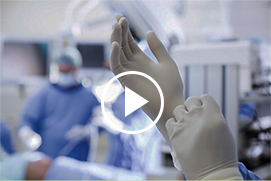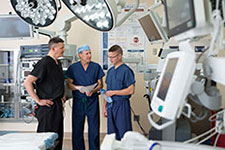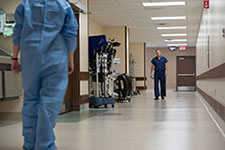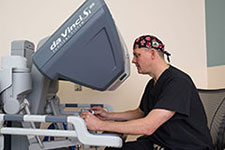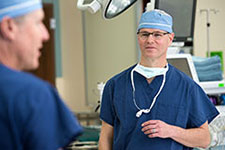What is a hernia?
A hernia occurs when a section of intestine protrudes through a weakness in the abdominal muscles. A soft bulge is seen underneath the skin where the hernia has occurred.
In babies, a hernia usually occurs in one of two places:
- Around the belly button
- In the groin area
A hernia that occurs in the belly button area is called an umbilical hernia.
A hernia that occurs in the groin area is called an inguinal hernia.
What causes a hernia?
A hernia can develop in the first few months after the baby is born because of a weakness in the muscles of the abdomen. Inguinal and umbilical hernias happen for slightly different reasons.
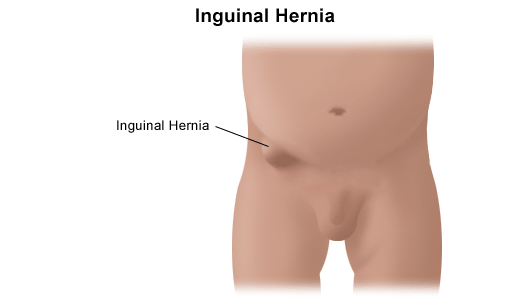
What is an inguinal hernia?
As a male fetus grows and matures during pregnancy, the testicles develop in the abdomen and then move down into the scrotum through an area called the inguinal canal. Shortly after the baby is born, the inguinal canal closes, preventing the testicles from moving back into the abdomen. If this area does not close off completely, a loop of intestine can move into the inguinal canal through the weakened area of the lower abdominal wall, causing a hernia.
Although girls do not have testicles, they do have an inguinal canal, so they can develop hernias in this area as well. Inguinal hernias do not occur as frequently among females as they do in males.
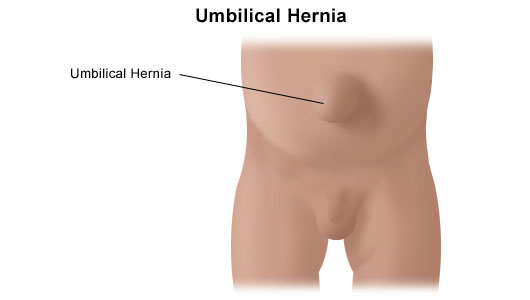
What is an umbilical hernia?
When the fetus is growing and developing during pregnancy, there is a small opening in the abdominal muscles so that the umbilical cord can pass through, connecting the mother to the fetus. After birth, the opening in the abdominal muscles closes as the baby matures. Sometimes, these muscles do not meet and grow together completely, and there is still a small opening present. A loop of intestine can move into the opening between abdominal muscles and cause a hernia.
Who is at risk for developing a hernia?
Hernias occur more often in babies who have one or more of the following risk factors:
- A parent or sibling who had a hernia as a baby
- Cystic fibrosis
- Developmental dysplasia of the hip
- Undescended testes
- Abnormalities of the urethra
Inguinal hernias occur:
- In 3 to 5 percent of full term infants
- Three times more often in premature infants
- In children who have a family history of inguinal hernias
- More often in infants and children with other urogenital anomalies
- More often in the right groin area than the left, but can occur on both sides
Umbilical hernias occur:
- More often in African-American babies
- More often in premature babies
Why is a hernia a concern?
Occasionally, the loop of intestine that protrudes through a hernia may become stuck, and is no longer reducible. This means that the intestinal loop cannot be gently pushed back into the abdominal cavity. When this happens, that section of intestine may lose its blood supply. A good blood supply is necessary for the intestine to be healthy and function properly.
What are the symptoms of a hernia?
Hernias usually occur in newborns, but may not be noticeable for several weeks or months after birth.
Straining and crying do not cause hernias; however, the increased pressure in the abdomen can make a hernia more noticeable.
- Inguinal hernias appear as a bulge or swelling in the groin or scrotum. The swelling may be more noticeable when the baby cries, and may get smaller or go away when the baby relaxes. If your doctor presses gently on this bulge when the baby is calm and lying down, it will usually get smaller or go back into the abdomen.
- Umbilical hernias appear as a bulge or swelling in the belly button area. The swelling may be more noticeable when the baby cries, and may get smaller or go away when the baby relaxes. If your doctor presses gently on this bulge when the baby is calm and lying down, it will usually get smaller or go back into the abdomen.
If the hernia is not reducible, then the loop of intestine may be caught in the weakened area of abdominal muscle. Symptoms that may be seen when this happens include the following:
- A full, round abdomen
- Abdominal pain and tenderness
- Vomiting
- Fussiness
- Redness or discoloration adjacent to the hernia
- Fever
The symptoms of a hernia may resemble other conditions or medical problems. Always consult your baby's doctor for a diagnosis.
How are hernias diagnosed?
Hernias can be diagnosed by a physical examination by your baby's doctor. Your baby will be examined to determine if the hernia is reducible (can be pushed back into the abdominal cavity) or not. Your baby's doctor may order abdominal X-rays or ultrasound to examine the intestine more closely, especially if the hernia is no longer reducible.
What is the treatment for hernias?
Specific treatment will be determined by your baby's doctor based on:
- Your baby's gestational age, overall health, and medical history
- The type of hernia
- Whether the hernia is reducible (can be pushed back into the abdominal cavity) or not
- Your baby's tolerance for specific medications, procedures, or therapies
- Your opinion or preference
Inguinal hernia. An operation is necessary to treat an inguinal hernia. It may be surgically repaired fairly soon after it is discovered, since the intestine can become stuck in the inguinal canal. When this happens, the blood supply to the intestine can be cut off, and the intestine can become damaged. Inguinal hernia surgery is usually performed before this damage can occur.
During a hernia operation, your baby will be placed under anesthesia. A small incision is made in the area of the hernia. The loop of intestine is placed back into the abdominal cavity. The muscles are then stitched together. Sometimes, a piece of mesh material is used to help strengthen the area where the muscles are repaired.
A hernia operation is usually a fairly straightforward procedure. Otherwise healthy babies who have an inguinal hernia surgically repaired can often go home the same day they have the operation.
Umbilical hernia. By age 1, many umbilical hernias will have closed on their own without requiring surgery. Nearly all umbilical hernias will have closed without surgery by age 5.
Placing a coin or strap over the hernia will not fix it.
There are many opinions about when a surgical repair of an umbilical hernia is necessary. In general, if the hernia becomes bigger with age, is not reducible, or is still present after age 3, your doctor may suggest that the hernia be repaired surgically. Always consult your baby's doctor to determine what is best for your child.
During a hernia operation, your baby will be placed under anesthesia. A small incision is made in the umbilicus (belly button). The loop of intestine is placed back into the abdominal cavity. The muscles are then stitched together. Sometimes a piece of mesh material is used to help strengthen the area where the muscles are repaired.
Otherwise healthy babies who have an umbilical hernia surgically repaired may also be able to go home the same day they have the operation.
What is the long-term outlook for this disorder?
Once the hernia is closed, either spontaneously or by surgery, it is unlikely that it will recur. The chance for recurrence of the hernia may be increased if the intestine was damaged.



